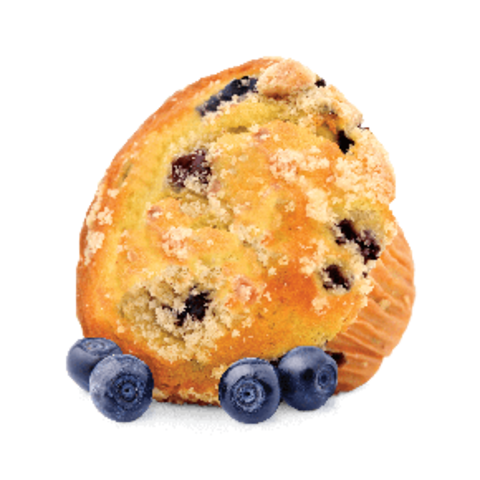
This image has format transparent PNG with resolution 480x480.
You can download this image in best resolution from this page and use it for design and web design.
Muffin PNG with transparent background you can download for free, just click on download button.
A muffin is an individual-sized, baked product. It can refer to two distinct items, a part-raised flatbread and a cupcake-like quickbread. The flatbread is of British or European derivation, and dates from at least the early 18th century, while the quickbread originated in North America during the 19th century. Both are common worldwide today.
Quickbread muffins (known in Britain as "American muffins" or simply as "muffins") originated in the United States in the mid-19th century. The use of the term to describe what are essentially cup cakes or buns did not become common usage in Britain until the last decades of the 20th century on the back of the spread of coffee shops such as Starbucks. (There is lingering resistance in the UK to the term as being inapplicable to cakes.) They are similar to cupcakes in size and cooking methods, the main difference being that cupcakes tend to be sweet desserts using cake batter and which are often topped with sugar icing (American frosting). Muffins are available in both savoury varieties, such as cornmeal and cheese muffins, or sweet varieties such as blueberry, chocolate chip, lemon or banana flavours. They are often eaten as a breakfast food, often accompanied by coffee or tea. Fresh baked muffins are sold by bakeries, donut shops and some fast food restaurants and coffeehouses. Factory baked muffins are sold at grocery stores and convenience stores and are also served in some coffee shops and cafeterias.
Recipes for quick bread muffins are common in 19th-century American cookbooks. Recipes for yeast-based muffins, which were sometimes called "common muffins" or "wheat muffins" in 19th-century American cookbooks, can be found in much older cookbooks. In her Boston Cooking-School Cook Book, Fannie Farmer gave recipes for both types of muffins, both those that used yeast to raise the dough and those that used a quick bread method, using muffin rings to shape the English muffins. Farmer indicated that stove top "baking", as is done with yeast dough, was a useful method when baking in an oven was not practical
Flatbread muffins (known in the United States and elsewhere as "English muffins", or simply 'muffins' in Britain) were first mentioned in literature in the early 18th century, although the product is undoubtedly older than that. The word "muffin" is thought to derive from the German mouffin.
This product is a flatter disk-shaped, typically unsweetened bread of English or European origin. These muffins are popular in Commonwealth countries and the United States. Flatbread muffins are often served toasted for breakfast. They may be served with butter or margarine, and topped with sweet toppings, such as jam or honey, or savoury toppings (e.g., round sausage, cooked egg, cheese or bacon). Flatbread muffins are typically eaten as a breakfast food.
The flatbread muffin is a type of yeast-leavened bread; generally about 4 in (10 cm) round and 1.5 in (3.8 cm) tall. Rather than being oven-baked, they are cooked in a griddle on the stove top and flipped from side-to-side, which results in their typical flattened shape rather than the rounded top seen in baked rolls or cake-type muffins. Flatbread muffins were known to American settlers, but declined in popularity with the advent of the quickbread muffin. They were re-introduced to the American market in 1880 as "English muffins" by English-American baker Samuel Beth Thomas (whose baked-goods company Thomas' survives to this day).
Muffin tins and muffin pans are typically metal bakeware which has round bowl-shaped depressions into which muffin batter is poured. Muffin tins or pans can be greased with butter or cooking spray, to lessen the issue of batter sticking to the pan. Alternatively, muffin cups or cases are used. Cups or cases are usually round sheets of paper, foil, or silicone with scallop-pressed edges, giving the muffin a round cup shape. They are used in the baking of muffins to line the bottoms of muffin tins, to facilitate the easy removal of the finished muffin from the tin. The advantage to cooks is easier removal and cleanup, more precise form, and moister muffins; however, using them will prevent a crust from forming. A variety of sizes for muffin cases are available. Slightly different sizes are considered "standard" in different countries. Miniature cases are commonly 1 to 1.25 in (25 to 32 mm) in diameter at the base and .75 in (19 mm) tall. Standard-size cases range from 1.75 to 2 inches (44 to 51 mm) in diameter at the base and are 1.25 to 1.5 in (32 to 38 mm) tall. Some jumbo-size cases can hold more than twice the size of standard cases. Australian and Swedish bakers are accustomed to taller paper cases with a larger diameter at the top than American and British bakers.
A Muffineer was originally a sugar shaker, looking like a large salt cellar with a perforated decorative top, for spreading powdered sugar on muffins and other sweet cakes. Later, in the 19th century, the term was also used to describe a silver, or silver-plated, muffin dish, with a domed lid and a compartment below for hot water, used to keep toasted English muffins warm before serving.
In this page you can download free PNG images: Muffin PNG images free download